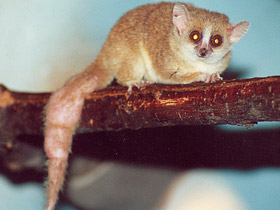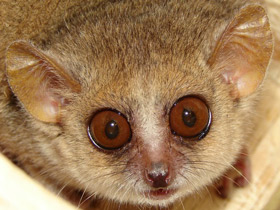The gray mouse lemur (Microcebus murinus), grey mouse lemur or lesser mouse lemur
The gray mouse lemur (Microcebus murinus), grey mouse lemur or lesser mouse lemur, is a small lemur, a type of strepsirrhine primate, found only on the island of Madagascar.
Taxonomy
As its name implies, the gray mouse lemur is a lemur, a type of primate, and belongs to the suborder Strepsirrhini and infraorder Lemuriformes. Within Lemuriformes, it belongs to the family Cheirogaleidae, which contains the mouse lemurs, dwarf lemurs, giant mouse lemurs, fork-marked lemurs, and hairy-eared dwarf lemur. The mouse lemur genus Microcebus includes the smallest primates in the world. Phylogenetic analyses of D-loop DNA sequences of various lemur species suggest that the gray mouse lemur may be most closely related to the reddish-gray mouse lemur (Microcebus griseorufus).
In 1777 the English illustrator John Frederick Miller included a hand-coloured plate of the gray mouse lemur in his Icones animalium et plantarum and coined the binomial name Lemur murinus. The species was moved to the genus Microcebus by the French naturalist Étienne Geoffroy Saint-Hilaire in 1834. Microcebus murinus remained the only species of its genus, as well as the name used for all mouse lemurs on Madagascar, between the first major taxonomic revision in 1931 and an extensive field study conducted in 1972. The field study distinguished the brown mouse lemur, Microcebus rufus—then considered a subspecies—as a distinct, sympatric species in the southeastern part of the island. Upon this revision, the gray mouse lemur was thought to account for all mouse lemurs that lived in the drier parts of the north, west, and south, while the brown mouse lemur represented the eastern rainforest mouse lemurs. More recently, scientific understanding of the distribution and diversity of the mouse lemurs has become much more complex. Additional field studies, genetic testing, and resulting taxonomic revisions throughout the 1990s and 2000s identified numerous new mouse lemur species, demonstrating that the genus includes at least 17 cryptic species.
Appearance and characteristics
The grey mouse lemur (Microcebus murinus), grey mouse lemur or lesser mouse lemur is a species of primate mammal in the family Cheirogaleidae.
Weighing between 58 and 67 grams and measuring between 12 and 14 centimetres in length, the grey mouse lemur is the largest member of the mouse lemur family, which includes all of the world's smallest primates. Interestingly, although these animals show no sexual dimorphism, males are noticeably heavier than females during the breeding season and vice versa during the rest of the year.
The huge eyes of this nocturnal animal are equipped with a layer of special light-reflecting cells behind the retina, allowing it to see perfectly in the dark during its solitary foraging for food in the trees.
The grey mouse lemur inhabits the flat, dry tropical forests, thorn bush thickets of the semi-arid belt and the evergreen forests of the alluvial plains of Madagascar.
During the day, the grey mouse lemur sleeps in a leaf-lined hollow or in a ball-shaped nest, which it builds from dry leaves, moss and small branches. Sometimes up to 15 females may gather in a nest (males prefer to rest alone or in small groups).
Interestingly, the grey mouse lemur has only females that enter anabiosis, while males remain active throughout the year. The exceptionally diverse diet of the grey mouse lemur includes leaves, fruits, resin, honey, flowers, flowers, spiders, insects (beetles, moths, mantises, crickets and cockroaches). Sometimes these crickets even feed on small vertebrates, such as tree frogs, geckos and chameleons.
On tree branches, grey mouse lemurs run fast and eagerly, and can jump up to 3 metres using their tail as a balancer. Grey mouse lemurs rarely come down to the ground, only to hunt insects or to cross an open area on their way to a desired tree. With a quick dash through the leaves, the grey mouse lemur catches an insect or other prey and carries it in its mouth to the tree, where it slowly and silently eats it.
Reproduction
Reproduction in grey mouse lemurs is seasonal; mates determine each other's species identity by their voice. Gestation lasts about 60 days and 2 young are usually born. At two months of age, grey mouse lemurs become independent, and from the age of one year they are able to reproduce.
Classification of species
The genus of grey mouse lemurs now includes several species that are so difficult to distinguish externally that for a long time they were considered a single species. Zoologists keep finding more and more species of grey mouse lemurs in Madagascar: there are now more than 20, the latest being discovered in 2012. Many of them live in a very limited area and may disappear from the face of the Earth before we know anything about their lives.

















































